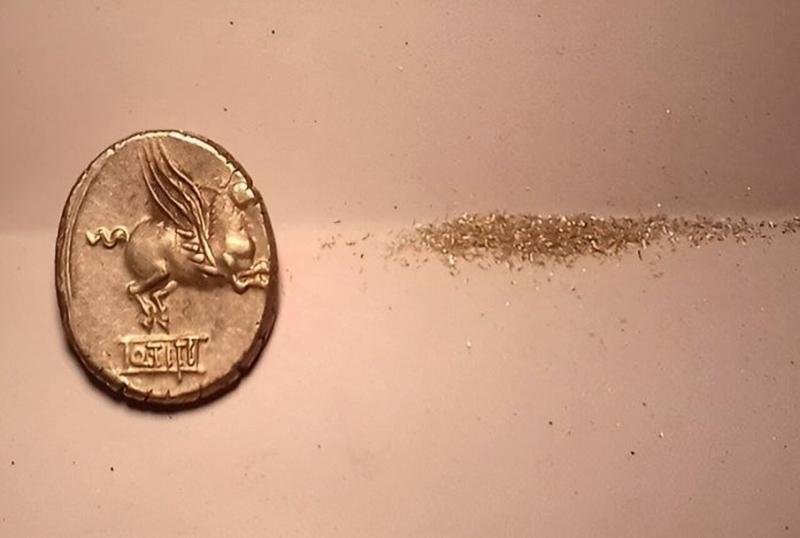Recent research conducted by experts from the University of Liverpool and the University of Warwick has unveiled the remarkable recycling practices of the ancient Romans, shedding light on their environmental consciousness.
The study, published in the journal “Archaeological and Anthropological Sciences,” provides intriguing insights into how the Romans ingeniously recycled silver to produce their coins, utilizing two primary clues: gold impurities in silver coins and pollution patterns in Greenland ice.
When silver was extracted from ores and refined at mints, it resulted in significant lead pollution. This pollution, with its far-reaching effects, even crossed the Atlantic Ocean, leaving behind a distinctive “pollution fingerprint” in Greenland’s ice. Despite continued coin production during the late Roman Republic, there was a notable decline in lead pollution levels within the ice.
 Sampling a Roman Republican denarius for chemical analysis. Credit: University of Liverpool
Sampling a Roman Republican denarius for chemical analysis. Credit: University of Liverpool
The likely explanation for this drop in pollution levels can be traced back to the tumultuous period of the first and second centuries BCE when Rome faced interruptions in its access to silver mines in regions like Iberia (modern-day Spain) and southern France. While it’s true that the Romans intentionally adulterated their predominant silver coin, the denarius, with copper, indicating reduced silver production, this alteration alone doesn’t entirely account for the reduction in lead pollution.
The researchers of this study, Dr. Jonathan Wood and Dr. Matthew Ponting, attribute the Romans’ ability to recycle silver as the key factor. They frequently sourced silver through the recycling of spoils acquired after conflicts in Iberia and southern France for coin production.
The study provides a timeline of silver’s transformation as an indication of recycling practices. Around 120 BCE, clusters of coins began to appear with notably low levels of gold content. This silver later reappeared in coins from the first half of the first century BCE. In 49 BCE, a sudden influx of silver with high gold content entered circulation, coinciding with Julius Caesar’s return to Rome from his conquests against the Gauls. Researchers speculate that this new silver, rich in gold, was plundered by Caesar’s army.
Dr. Jonathan Wood emphasized, “Debasing silver was one way to cope with fluctuations in the silver supply. Melting down existing silver, whether your own or someone else’s, was another. For the Romans, recycling coins would have been considerably less expensive than extracting new silver, providing financial and environmental benefits.”
This discovery is a part of a larger effort to comprehend how the Romans harnessed currency as a tool for expanding their empire. It underscores the Romans’ resourcefulness, exemplifying how recycling, much like modern practices, not only benefits the environment but also proves cost-effective.
The study represents an important contribution to our understanding of ancient recycling practices, emphasizing the Romans’ pioneering role in an early form of recycling that was both economically savvy and ecologically responsible.
More information: Wood, J.R., Ponting, M. & Butcher, K. (2023). Crisis? What crisis? Recycling of silver for Roman Republican coinage. Archaeol Anthropol Sci 15, 147.





